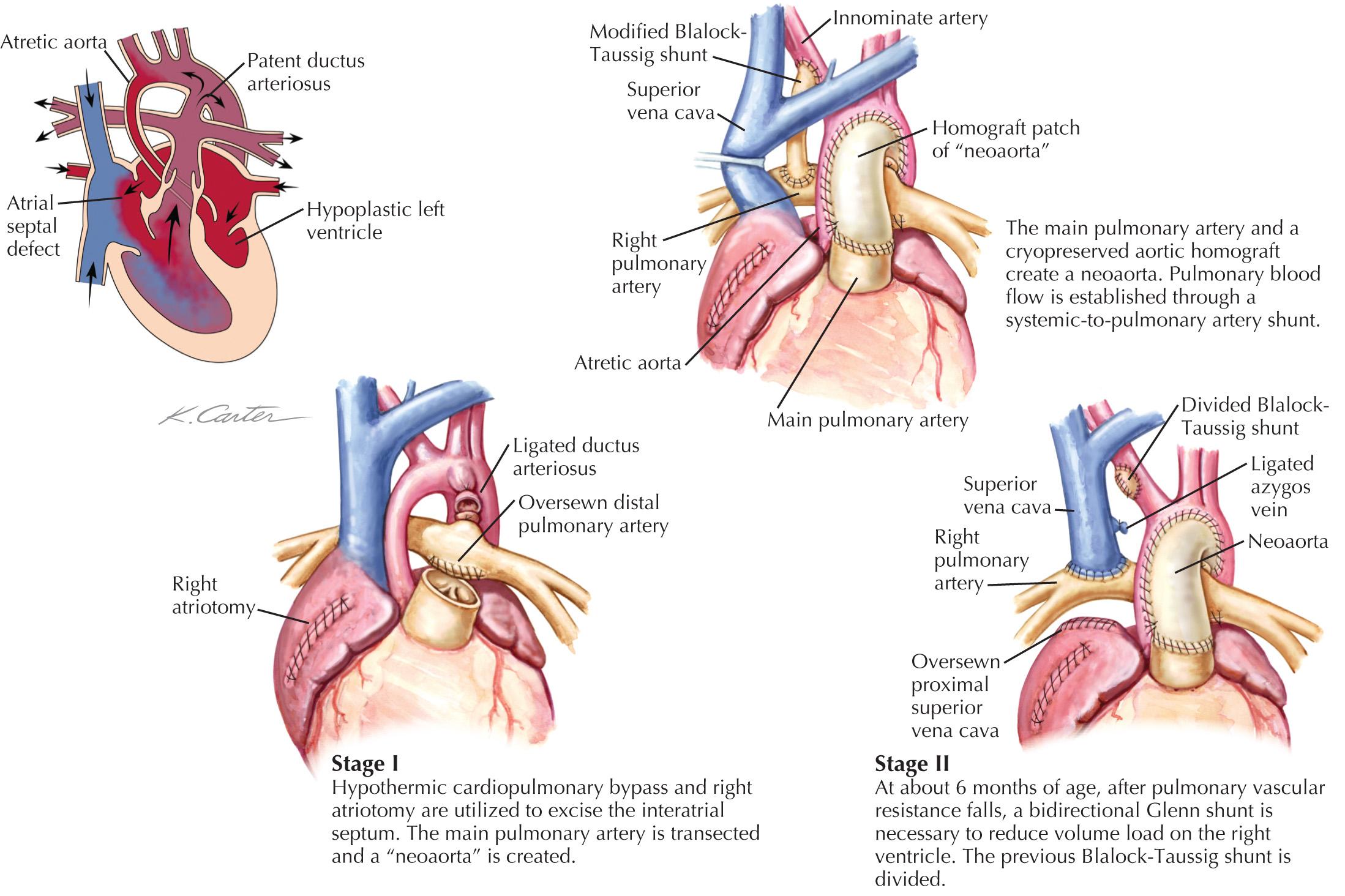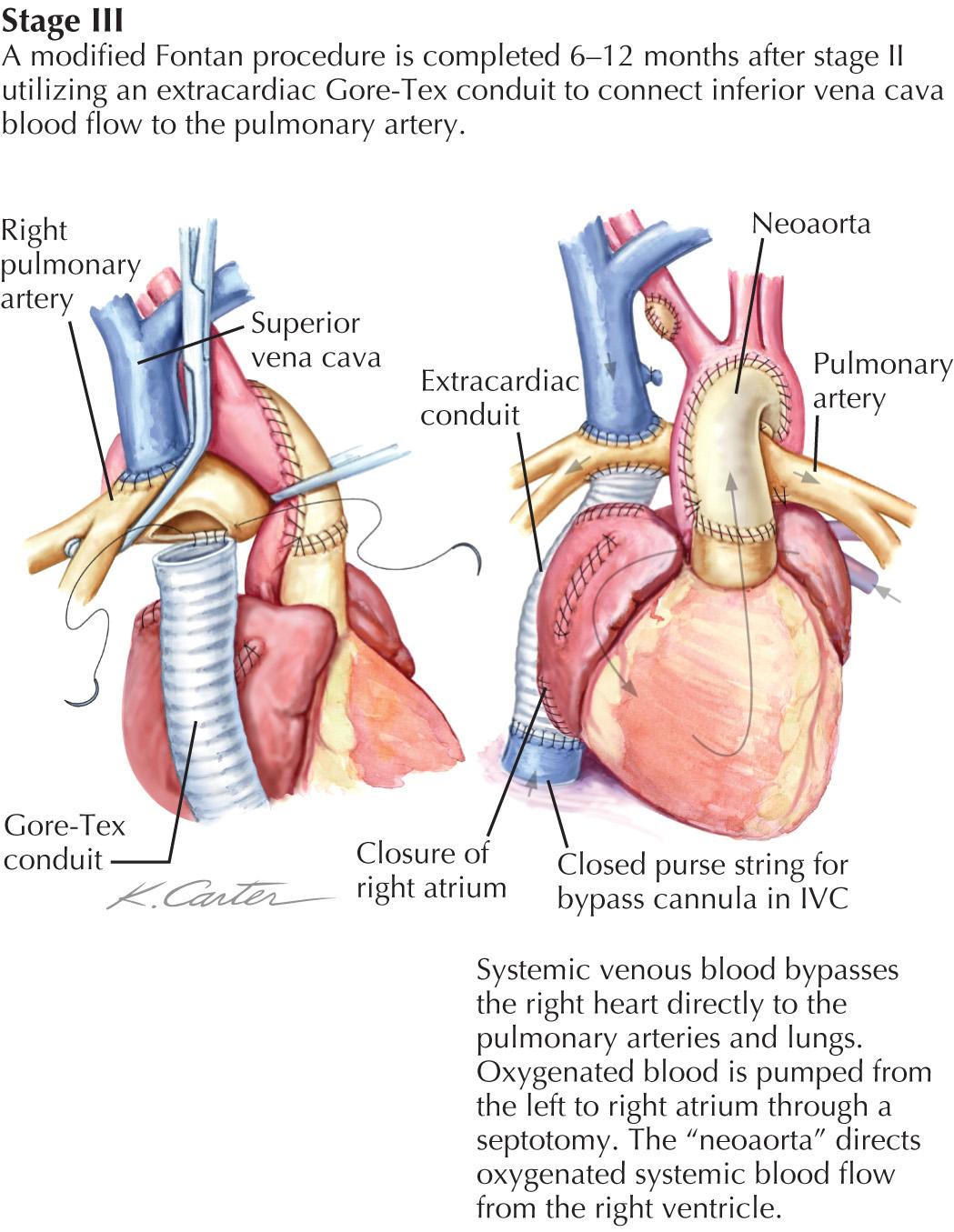Physical Address
304 North Cardinal St.
Dorchester Center, MA 02124
Our understanding of the complexities of congenital heart disease, which is a deviation from normal cardiac anatomic development that affects 8 in 1000 births, has progressed immensely since the establishment of the Board of Pediatric Cardiology in 1961. Improvements in diagnostic imaging (including echocardiography, cardiac angiography, and MRI) and innovations in surgical repair techniques have resulted in greatly improved outcomes for children with congenital heart disease. This chapter provides a broad overview of the most common congenital heart lesions and the role of surgical interventions.
Embryological development of the heart begins with the fusion of angiogenic cell clusters within the splanchnic mesoderm layer of the primitive embryo to form the heart tube at 18 to 21 days of gestation. The heart begins to rhythmically contract as early as day 17, once functional units of the myocytes begin to form. Myocardial growth proceeds with segmentation and looping of the heart tube, as well as cellular differentiation and migration along the embryological axes, with the establishment of laterality, and with the organization of the primitive cells into a sophisticated organ. Deviations from this complex process of cardiac development lead to congenital cardiac anomalies, with clinical presentations that in some cases occur in the immediate postnatal period and in other cases in young adulthood.
Therapy for congenital heart disease has evolved with surgical and nonsurgical innovations. The development of pediatric cardiac surgery has led to the survival of many children with complex congenital heart disease. These successes have depended on improved diagnoses, advances in surgical technique, and the development of extracorporeal circulation—cardiopulmonary bypass (CPB). Complex repairs for previously fatal lesions such as transposition of the great arteries (TGA) and hypoplastic left-sided heart syndrome (HLHS) have become routine, with declining mortality rates and improved long-term outcomes. The development of transcatheter procedures has made therapeutic cardiac catheterization a viable alternative to surgery for specific congenital cardiac lesions.
Many congenital heart lesions can be surgically repaired, meaning that approximately normal anatomy and physiology are established. The closure of atrial septal defects (ASDs) and ventricular septal defects (VSDs) can, when successfully accomplished in a young patient, eliminate the long-term consequences of the defect. Other lesions, most notably, the single-ventricle defects, cannot be repaired but can be successfully palliated with operative modifications that provide a viable alternative for cardiopulmonary physiology. These palliative operations can also be useful as a bridge to complete repair after a period of growth and development.
The Blalock-Taussig (BT) shunt was first performed in 1944 at the Johns Hopkins Hospital (Baltimore, Maryland) to supply blood to the branch pulmonary arteries (PAs) of a severely cyanotic patient with tetralogy of Fallot (TOF). The shunt was created by dividing the right subclavian artery and directly anastomosing it to the right PA. Since that time, the creation of a systemic-to-PA shunt (a BT shunt) has been used for a variety of congenital heart defects with severe PA stenosis or atresia as a bridge to more definitive surgical correction. The technique of creating a BT shunt has been modified significantly by using an interposition graft, most commonly made of expanded polytetrafluoroethylene(ePTFE) (Gore-Tex; W. L. Gore & Associates, Newark, Delaware), between the systemic and pulmonary vessels. The modified BT shunt operation can be performed through a lateral thoracotomy or a median sternotomy, and can be performed on either the right or the left. A significant development in congenital heart surgery has been the increasing trend toward definitive repair at an earlier age, including the neonatal period. For this reason, the use of BT shunts is decreasing, but remains an important tool for the palliation of cyanotic heart lesions.
The PA band is an important palliative procedure for congenital heart lesions in which there is excessive pulmonary blood flow. The PA band is simply a Teflon (DuPont, Wilmington, Delaware) tape looped around the main pulmonary trunk and tightened to restrict pulmonary blood flow. The PA band was originally developed to treat large VSDs by decreasing the left-to-right shunt. Currently, the PA band is most commonly used for single-ventricle lesions with nonrestrictive pulmonary blood flow. The band is used to balance the systemic and pulmonary circulations, and to protect the pulmonary vasculature from prolonged exposure to high pressure, which could lead to a fixed increase in pulmonary vascular resistance and irreversible pulmonary hypertension. The PA band in these patients with single ventricles is a bridge to eventual Fontan physiology, or total cavopulmonary blood flow. There are still some instances in which a PA band is useful for the treatment of a VSD, most commonly in patients with multiple VSDs, which are also known as a “Swiss cheese septum.”
The superior bidirectional cavopulmonary anastomosis, often referred to as the Glenn shunt, is the second stage in the palliation of all or most defects of the single-ventricle type. This shunt involves the disconnection of the superior vena cava (SVC) from the right atrium and a direct anastomosis of the SVC to the right PA ( Fig. 53.1 ). This allows all of the systemic venous return from the upper body to flow directly to the lungs. The Glenn shunt is typically performed between 4 and 9 months of age, allowing for enough lung maturity to permit this passive blood flow. Patients will not be fully saturated following the Glenn shunt, because the venous return from the lower body still returns to the heart to mix with the fully oxygenated pulmonary venous blood. Depending on the particular cardiac defect, the procedure may be combined with the removal of a BT shunt or removal of a PA band, with division of the main pulmonary trunk from the heart. In either instance, the attendant decrease in the volume load on the heart is beneficial to the function of the single ventricle and its long-term durability.

The ability of the pulmonary circulation to accept the entire cardiac output passively is limited, and thus, this is the rationale for creating total cavopulmonary circulation in two stages. The Glenn shunt is performed in the first year of life, and the completion of the Fontan is done in the second or third year of life. There are two distinct techniques for completing the Fontan: the lateral tunnel and the extracardiac conduit. The lateral tunnel involves creating a tunnel inside of the right atrium that extends from the opening of the inferior vena cava (IVC) to the opening of the SVC, which is, in turn, connected to the right PA, thus baffling all of the systemic venous return to the lungs. The extracardiac Fontan is created by disconnecting the IVC from the right atrium and sewing a graft of ePTFE from the open end of the IVC to the PAs ( Fig. 53.2 ). Using either strategy, a direct connection of the IVC flow to the lungs establishes total cavopulmonary circulation, with the result being that after repair, the patient should have nearly normal oxygen saturation. Postsurgical outcomes with the Fontan, with either technique, have improved, with most recent data showing 95% 10-year survival.

Tricuspid atresia is a rare congenital lesion with an absent right-sided arteriovenous connection and occurs only in <1% of patients with congenital heart disease. Left ventricular preload is dependent on interatrial blood flow via an ASD. This lesion is commonly associated with transposed great vessels, and the PA can range anywhere from atretic to enlarged. The physiology of the lesion varies by the amount of pulmonary blood flow. The original surgical repair, the classic Fontan procedure, involved constructing a direct connection between the right atrium and the main PA. Present-day conversion to the Fontan circulation usually requires a two-stage surgical approach after early palliation. The initial palliation may involve a BT shunt for lesions that include pulmonary stenosis or a PA band for those with a normal PA and excessive blood flow. A Glenn shunt is then created between 4 and 9 months of life, followed by the Fontan procedure, which is performed between 12 months and 3 years of age. In the Fontan era, mortality for tricuspid atresia decreased significantly, with 81% 1-year survival and 70% 10-year survival.
HLHS is a congenital lesion with univentricular physiology. HLHS generally involves a diminutive nonfunctional left ventricle that results from stenosis or atresia in both the mitral and aortic valves, as well as hypoplasia of the ascending aorta. Systemic blood flow is ductal-dependent, and the appearance of symptoms in the neonatal period usually correlates with spontaneous closure of the ductus arteriosus. Early management with prostaglandin E 1 to maintain ductal patency is life sustaining. The appropriate balance between pulmonary and systemic blood flow (Qp/Qs) is critical. The most common neonatal palliative approach is the Norwood procedure, in which a “neoaorta” is created by performing an aortopulmonary connection, then augmenting the hypoplastic ascending aorta with a homograft patch. A systemic-to-pulmonary shunt is required for pulmonary blood flow, and an atrial septectomy is always performed to permit unobstructed flow of left atrial blood through the tricuspid valve to the right ventricle (see Figs. 53.1 and 53.2 ). The surgery is usually performed during the neonatal period and carries a 20% to 30% risk of mortality. The Norwood procedure is followed by a bidirectional Glenn shunt at 4 to 6 months of age and a Fontan procedure at 2 to 3 years of age.
Patent ductus arteriosus describes postnatal persistence of a normal fetal vascular connection between the main pulmonary trunk or proximal left PA and the descending thoracic aorta. This anomaly accounts for 10% of congenital heart lesions. In full-term infants, the ductus arteriosus is usually functionally closed by 10 to 15 hours after birth. Persistent blood flow through the ductus arteriosus is often associated with other congenital anomalies, and depending on the vascular connections, pulmonary blood flow may be dependent on patency of the ductus, as in lesions with right ventricular (RV) outflow tract obstruction. In this case, the vessel may be kept open with prostaglandin E 1 therapy until a BT shunt is surgically created. When no other associated anomalies exist, and ductus closure has not occurred after medical therapy with indomethacin for 48 to 72 hours, direct surgical ligation or division via a left posterolateral thoracotomy, or alternatively, catheter-based device closure, is indicated. Surgical closure before 10 days of age reduces the duration of ventilatory support, the length of hospital stay, and overall morbidity.
Become a Clinical Tree membership for Full access and enjoy Unlimited articles
If you are a member. Log in here